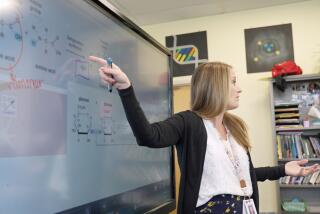Technology Tests Schools’ Ability to Teach
- Share via
When I was a college student, luxuriating in the liberal arts and thinking as little as possible about my career, I decided to fulfill a (minimal) math and science requirement by taking an introductory computer course--and thus learned to program in a language called Fortran.
The textbook was titled “Fortran for Humans”--today it would undoubtedly be called “Fortran for Dummies,” a shift whose symbolism I don’t even want to contemplate--and that’s the main thing I remember about the class. I was a most uninspired programmer.
Even if I had liked programming, it wouldn’t have done me much good to know Fortran, which even then, in 1980, was all but obsolete. Learning the principles of how computers worked had some value, but in the end the class amounted to an odd and virtually useless effort to promote some vague idea of “computer literacy.”
Today computer literacy is more in vogue than ever but is no better understood. Despite the current frenzy to equip schools with computers and wire them to the Internet, there’s little agreement on what kinds of technological skills are essential, how those skills should be taught, and whether proficiency with computers should be incorporated into statewide or national educational standards, codes and testing programs.
I’ve always been skeptical of the value of computers in the educational process, and the all-to-American tendency to see technology as a silver bullet for our troubled schools is downright dangerous.
Politicians and computer industry leaders are doing us all a disservice by overselling the importance of technology, especially in teaching traditional subjects like English or history.
Still, computers clearly have a place in the schools. Anyone who wants to be a fully functioning member of society in the decades to come will need to have at least a basic familiarity with computer operations. Upper-middle-class kids who grow up with computers and video-game machines and other gadgets become comfortable using a keyboard and mouse almost by osmosis, but the same doesn’t apply for less privileged children.
The questions pop up immediately though. Does being comfortably with a PC mean learning Windows 95 or Mac OS 8 in detail? Or Microsoft Word? Or Adobe Photoship? There’s a very thin line between what’s important a general skill for an educated person in the 1990s, and what amounts to vocational training for certain white- or pink-collar jobs.
Andrew Duneau, technology director for the Los Angeles Education Partnership, says that learning basic applications, such as word processors or spreadsheets, develops “thought processes which are always applicable”--even if the student never moves on to a job that requires knowledge of those particular computer programs, or even if the programs become obsolete. Yet to me that sounds dangerously close to the justification for learning Fortran.
The inexorable trend in the technology world is for machines to become more complicated on the inside and simpler on the outside. Even programming is becoming easier with the constant development of more sophisticated tools. There just aren’t very many computer skills that have broad, long-lasting applicability.
Even after they make the difficult decisions about what kinds of computer skills students should have, teachers and school administrators must then decide how to teach them. Should computers be a subject unto themselves, like math or science or social studies, as they often are in high schools? Or should computer skills be taught by using the technology in the teaching of math or science or social studies?
The latter view seems to be in vogue these days. Computer skills “need to be taught in a context that makes them meaningful, in a learning environment where you can use them” says Cheryl Lemke, formerly associate superintendent for Illinois and now vice president of technology at the Santa Monica-based Milken Foundation’s education technology clearinghouse.
A junior high school student preparing a report on the Middle East, say, might use the Internet to help with the research, and then put together a multimedia computer presentation rather than a simple text report. Thus she’d learn a variety of computer skills along with social studies.
That sounds good, but it immediately runs up against the problems that plague most efforts to use computers as instructional tools for non-computer subjects: Few teachers have the training to integrate technology effectively into their teaching plans and to guide students in using a problematic research tool like the Internet, and many schools don’t have enough up-to-date computers, the personnel to support them, and the money to pay for supplies.
Intimately linked to the debate over the best means of teaching computer skills is the vexing problem of how to evaluate the ends.
Philosophical differences over how to teach certain types of skills are hardly unique to computers: Witness the battles over “whole language” reading programs or “new-new math”. And judging the effectiveness of a given teaching method is always difficult. But the immense disparities in computer resources and teaching methods even within individual school districts make comprehensive assessment of computer competence especially difficult.
Given these obstacles, it’s not surprising that state education authorities and school districts have been slow to develop computer-education guidelines.
The state of North Carolina is alone in having developed a grade-by-grade computer-skills curriculum. In California, officials are developing a set of proficiency standards for computers, with the aim of integrating them into overall statewide guidelines for grade progression and graduation.
Clearly, a huge amount of work remains to be done nationwide in integrating computer skills into the school curriculum.
While creative teachers who take an interest in computers are finding ways to use them well, the formalization and broad dissemination of effective practices has only just begun. If this isn’t done well, and fairly quickly, there’s a danger that new generations of students will end up knowing the 1990s equivalents of Fortran.






